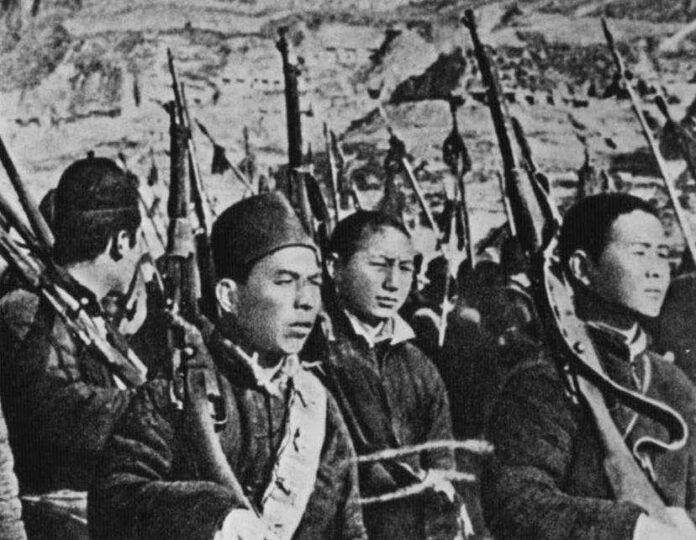Translator: JJ Lin
In October 1934, under intense encirclement and suppression by the nationalist Kuomintang, the Chinese Communist Party (CCP) broke out of its base in Jiangxi and embarked on a grueling journey to Yan’an. Despite suffering heavy losses and sacrifices, this strategic retreat allowed the CCP to regroup and survive. The operation, later named the Long March by Mao Zedong in 1935, has since become a landmark event in military history.
The Long March, on one hand, showcased Mao Zedong’s remarkable strategic and tactical abilities, enabling the CCP to evade destruction and escape Chiang Kai-shek’s relentless pursuit. On the other hand, it also reflected the CCP’s political failures—its inability to sustain workers’ radicalization led to the extinguishing of the revolutionary momentum among the proletariat. Thus, the Long March can be seen as a direct consequence of the CCP’s political setbacks.
This article examines the historical events of the Long March while delving into its political significance and the lessons it offers.
The Consequences of Political Mistakes
As previously recounted,[1] the Chinese Communist Party (CCP), formed in 1921, lacked sufficient experience and was further hindered by erroneous instructions from the Stalinist bureaucracy. These factors led CCP members to join the Kuomintang (KMT) in their personal capacities, initiating the first phase of KMT-CCP cooperation. However, as revolutionary momentum grew, it increasingly threatened the KMT. In 1927, Chiang Kai-shek responded with the “Purge of the Party,” a brutal crackdown that resulted in the massacre of CCP members and labor activists, particularly in Shanghai.
Despite the catastrophic consequences of the counter-revolution, the Stalinist bureaucracy refused to take responsibility for its mistakes. Instead, during the August 7, 1927, conference (the 87 Conference), it placed the blame entirely on then-CCP leader Chen Duxiu and pivoted to a policy of armed resistance.
Leon Trotsky, however, argued that the Chinese revolution had already suffered a decisive defeat by 1927. He emphasized the need to “establish and consolidate bases across all aspects of the workers’ movement, build rural branches, and lead and unify fragmented struggles—initially defensive, then offensive—by workers and poor peasants.”[2] In contrast, the Stalinist bureaucracy’s “Third Period” adventurist policies deepened the crisis for the Chinese revolution.
At the Ninth Plenum of the Executive Committee of the Comintern in February 1928, the defeat of the revolution was entirely dismissed. The meeting doubled down on the policy of armed resistance adopted at the 87 Conference. Similarly, at the CCP’s Sixth National Congress in June 1928, while the CCP acknowledged the defeat in a limited manner and criticized blind activism, it upheld strategies similar to those of the Ninth Plenum.[3]
This insistence on an unrealistic and blind offensive course inflicted devastating losses on the CCP, exacerbated by the dominance of Stalin’s faction (a group largely composed of Soviet-trained members, with Wang Ming as its key representative). As Liu Shaoqi later observed during the CCP’s Eighth National Congress: “At that time, the Workers’ and Peasants’ Red Army lost 90 percent of its forces, while the party organizations and revolutionary groups under the Kuomintang lost nearly 100 percent.”[4]
The Long March Begins
After the Shanghai Massacre in April 1927, the Wuhan National Government responded to Chiang Kai-shek’s call to purge the Communist Party in August of the same year, further worsening the CCP’s position in urban areas. Facing increasing challenges and several failed uprisings, the CCP shifted its focus to the mountainous regions of Hunan and Jiangxi. There, they recruited peasants and even bandits through land reform programs, formally establishing the Chinese Soviet in 1931. Against this backdrop, Mao Zedong’s strategic vision of “using the countryside as a revolutionary base” began to take root within the CCP and grew in significance over time.[5]
Between 1930 and 1934, the Kuomintang (KMT) launched four large-scale military campaigns to encircle and suppress the CCP forces, but each failed. As Edgar Snow noted, the CCP implemented progressive reforms in the Jiangxi Soviet areas, including land redistribution, reducing unemployment, eradicating illiteracy, and abolishing practices like prostitution and slavery. These measures significantly improved the living conditions of the local population, earning the CCP strong grassroots support and enabling them to withstand the KMT’s repeated campaigns.[6]
However, in October 1933, the KMT launched its fifth and largest encirclement campaign. Chiang Kai-shek mobilized nearly a million troops and all available resources, including modern equipment, 400 warplanes, and a team of German military advisers who devised advanced tactics. In stark contrast, the Red Army had about 200,000 guerrilla fighters but fewer than 100,000 rifles, only a handful of trained pilots, and severe shortages of artillery, bombs, and fuel.[7]
To avoid repeating past failures, the KMT adopted a total economic blockade during this campaign. Snow described this strategy as “the construction of a great wall around the Soviet area, gradually tightening, with the ultimate aim of encircling and crushing the Red Army.”[8] Confronted with this dire situation, the CCP ultimately decided to evacuate Jiangxi and search for a new base of operations.

Factional Conflict
The CCP’s internal power struggles in the Jiangxi Soviet region began as early as during the fourth encirclement and suppression campaign. One faction was led by Mao Zedong and the other, the Soviet-trained faction (SF), was headed by Wang Ming. Mao’s influence was significantly curtailed by the SF, which held full control of the Central Committee, accusing Mao of harboring a right-leaning “peasant consciousness.”[9]
However, the onset of the Long March exposed the SF’s inability to manage the Red Army effectively during the grueling retreat. In contrast, Mao Zedong’s tactical acumen, which had been instrumental in repelling previous KMT campaigns, became indispensable. As the CCP retreated further into remote mountainous areas, the Red Army increasingly relied on Mao’s deep understanding of rural strategy and conditions. This reliance shifted the balance of power within the CCP, enabling Mao to gain an advantage over the SF.[10]
In January 1935, during the Red Army’s march through Guizhou, the Zunyi Conference was convened. At this pivotal meeting, Mao Zedong was elected leader of the Red Army and appointed to the Politburo Standing Committee, marking his return to the center of CCP power. Wang Ming, by contrast, was ousted from his leadership position. By October of the same year, when the Red Army reached northern Shaanxi, its forces had dwindled to fewer than 10,000 soldiers.
Ultimately, the “victory” of the Long March was less a political triumph over the KMT and more about Mao Zedong’s ability to lead the Red Army to “survive” under the relentless pressure of the KMT’s forces. As historian Maurice Meisner observed: “It was a major political defeat to abandon the Chinese Soviet Republic and allow the peasants who had supported them to suffer reprisals from the Kuomintang army. The fact that most of the Red Army’s forces were destroyed in the cruel circumstances of the following year can hardly be considered a victory.”[11]
Nevertheless, the Long March marked the beginning of the cult of Mao Zedong. During this period, Mao was increasingly portrayed as a prophetic figure and savior.
The Yan’an Period and Maoism
In December 1936, the CCP’s central leadership relocated to Yan’an. The immense prestige gained from the Long March solidified Mao Zedong’s position as the de facto leader of the CCP. By 1938, Mao’s authority was officially recognized when a Soviet encyclopedia identified him as the party’s leader, and he was successfully elected as chairman of the Preparatory Committee for the CCP’s Seventh Party Congress. These milestones reflected growing acknowledgment of Mao’s dominance within the CCP.[12]
Although factional conflicts within the party persisted into the 1940s, Mao Zedong’s eventual victory in these power struggles was largely assured. The Yan’an period became a pivotal stage in Mao’s ascent to historical prominence. In 1942, Mao initiated the Yan’an Rectification Movement, which included the use of his own writings as mandatory study materials, further undermining the Soviet-trained faction (SF) led by Wang Ming. In 1945, during the Seventh Plenary Session of the CCP’s Sixth Central Committee, the party adopted the Resolution on Certain Questions in the History of Our Party, forcing Wang Ming to acknowledge his “left-leaning” mistakes. This move further consolidated Mao’s position as the CCP’s supreme leader.
During an era dominated by Stalinism, opposing Stalin and his proxies was an extraordinary challenge. Wang Fanxi analyzed Mao’s success in overcoming intra-party opposition: “Mao’s personal centralization of power, in the most direct sense, was the result of his defeat of Stalin’s agent in China (Wang Ming). In a broader sense, it stemmed largely from the real needs of the revolutionary struggle (especially the armed struggle) and, to a lesser extent, from Mao’s ambitions, which facilitated the rise of his cult of personality.”[13]
Historian Maurice Meisner argued that the Long March reinforced Mao’s belief in voluntarism—the conviction that all material challenges could be overcome through sheer revolutionary willpower. The sacrifices made during the Long March also instilled in survivors a near-religious devotion to the revolutionary cause, forming the essence of the “Yan’an Spirit” that was later celebrated. Following the Long March, Mao’s image became almost sanctified, and after the establishment of the People’s Republic of China in 1949, this veneration evolved into an extreme personality cult.[14]
Conclusion
From an objective perspective, the Long March stands as a significant innovation in military history. Mao Zedong’s tactical acumen enabled the CCP to break through the Kuomintang’s blockade and encirclement, providing the party with critical space and time to regroup. However, the cost was devastating. In its effort to eradicate the CCP, the Kuomintang inflicted widespread atrocities, slaughtering large numbers of peasants, women, and children during the fifth encirclement and suppression campaign. According to the Kuomintang’s own estimates, military operations in the Jiangxi Soviet region led to the deaths of at least one million people through killings, executions, and starvation. Afterward, the KMT forcibly relocated many survivors to eliminate the influence of the Soviet areas.[15]
The extraordinary circumstances of the Long March also laid the foundation for Mao Zedong’s cult of personality, built by his supporters[16]. This personal veneration became a critical factor in Mao’s ability to challenge Stalin’s authority later on. Mao’s emphasis on a peasant-based revolution, coupled with the Kuomintang’s destruction of the CCP’s urban bases, pushed the party into a reliance on rural guerrilla warfare, reshaping the trajectory of the Chinese revolutionary movement.
As previously discussed, the Stalinist bureaucracy bears significant responsibility for the CCP’s turn toward a peasant-based strategy. Misjudging the Chinese situation, the Comintern’s flawed directives caused the CCP to miss the revolutionary wave of 1925 and led to the catastrophic loss of cadres and activist workers during the Kuomintang’s April 1927 crackdown. Subsequent armed insurrections failed to deliver meaningful results, proving that the “higher stage of revolution” predicted by Stalinist doctrine was detached from reality. These missteps drove the CCP out of urban areas, severing its ties with the working class. Wang Fanxi aptly observed that the destruction of the CCP’s urban organization and its retreat to northern Shaanxi were not solely the result of the KMT’s suppression but also of the Comintern’s misguided policies and internal factionalism. This disconnect from the urban proletariat persisted until 1949, when the CCP gained power.[17] But, this approach played a key role in shaping the character of the regime.
While Mao Zedong’s peasant-based revolution ultimately succeeded in overthrowing the Kuomintang, it established a bureaucratic regime that lacked workers’ democracy and oversight.
As Marxists, it is crucial to learn from the successes and failures of the Chinese Revolution. To encapsulate these lessons, we can turn to Trotsky’s words: “If the Russian Revolution summons the Chinese Revolution, the unscrupulous disciples of Russia hang it.”[18]
[1] For details, see our article: “The 73rd Anniversary of the Founding of CCP: Historical Burdens and Future Challenges“.
[2] Leon Trotsky, Summary and Prospect of the Chinese Revolution: Its Lessons for the Eastern Countries and the Comintern as a Whole, in Trotsky on the Chinese Revolution (1925-1927). Translated by Shi Yongqin. Shaanxi People’s Press, 2011.
[3] Wang Fanxi, Memoirs of Shuangshan, in Selected Works of Wang Fanxi. City University of Hong Kong Press, 2018.
[4] Same as note 3.
[5] Maurice Meisner, 《Mao Zedong’s China and Beyond: A History of the People’s Republic of China》. Translated by Du Pu. The Chinese University of Hong Kong, 2005.
[6] Edgar Snow,《 Red Star Over China》. Translated by Dong Leshan. Beijing: Writers Publishing House, 2008.
[7] Same as note 6.
[8] Same as note 6.
[9] Maurice Meisner, The Birth of Maoism: The Road to China’s Communist Revolution. Translated by Wen Qiayi. New Taipei City: Acropolis Press, 2012.
[10] Same as note 9.
[11] Same as note 5.
[12] Xu Zhongyue, Modern Chinese History (II). Translated by Ji Qiufeng and Zhu Qingbao. The Chinese University of Hong Kong, 2002.
[13] Wang Fanxi, Essays on Mao Zedong Thought, in Selected Works of Wang Fanxi. City University of Hong Kong Press, 2018.
[14] Same as note 5.
[15] Same as note 6.
[16] Same as note 9.
[17] Same as note 3.
[18] Leon Trotsky, The Strangled Revolution: A Review of a French Novel Describing the Chinese Revolution, in Trotsky on the Chinese Revolution (1925-1927). Translated by Shi Yongqin. Shaanxi People’s Press, 2011.



